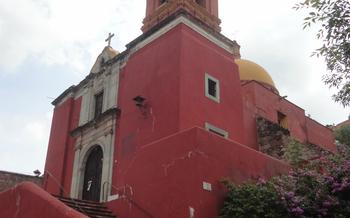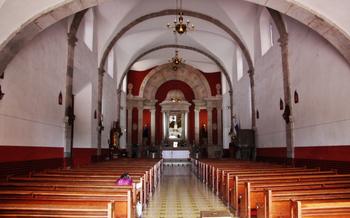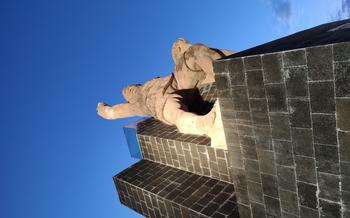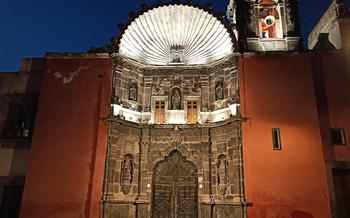
Guanajuato Silver Mines (Minas de Plata)
- Guanajuato Silver Mines (Minas de Plata)
- A Journey Through Time
- Unveiling the Treasures
- Engineering Marvels
- A Walk Through the Tunnels
- Guanajuato's Mining Heritage
- , located in Guanajuato, Mexico, holds the title of being the largest and most productive silver mine in the Americas during the colonial period. Its history dates back to the 16th century when Spanish conquistadors discovered rich silver veins in the area. The mine's name, Valenciana, derives from the Spanish word "valenciana," meaning "of Valencia," a nod to the Spanish investors who financed its operations.
- The Legend of El Pípila
- The Silver Route: A Journey Through Mining History
- Planning Your Visit
- Guanajuato City
- Safety Precautions
- Insider Tip: Unveiling Hidden Gems
Guanajuato Silver Mines (Minas de Plata)
The Guanajuato Silver Mines, also known as Minas de Plata, are a testament to Mexico's rich mining heritage and a must-visit attraction for anyone interested in history, culture, and engineering marvels. These mines have played a pivotal role in shaping the city of Guanajuato, contributing significantly to its economic prosperity and cultural identity.
Historical significance:
The Guanajuato Silver Mines date back to the 16th century when Spanish conquistadors discovered silver deposits in the region. The mines quickly became a major source of wealth for the Spanish Crown, and Guanajuato grew into one of the most important mining centers in the Americas.
Mining techniques:
The miners used various methods to extract silver from the ore, including the patio process, which involved crushing the ore, mixing it with mercury, and then heating it to separate the silver. This process, while effective, was also highly toxic, leading to health problems for the miners.
Cultural impact:
The mining industry had a profound impact on the culture of Guanajuato. The city became a melting pot of different cultures, as miners from all over the world came to seek their fortune. This cultural diversity is reflected in the city's architecture, cuisine, and traditions.
Location and accessibility:
The Guanajuato Silver Mines are located in the heart of the city, within easy walking distance from the main square. The mines are open to the public for guided tours, allowing visitors to explore the tunnels, learn about the history of mining in Guanajuato, and experience the unique atmosphere of these underground wonders.
A Journey Through Time
The history of the Guanajuato Silver Mines is a captivating tale that spans centuries, beginning in the pre-Hispanic era when indigenous communities extracted precious metals using rudimentary techniques. During the colonial period, the arrival of Spanish conquistadors marked a turning point, as they introduced advanced mining methods and established large-scale operations. The mines became a cornerstone of the Spanish Empire's wealth, fueling its economic prosperity and global influence.
Throughout the 18th and 19th centuries, mining flourished in Guanajuato, attracting skilled miners and entrepreneurs from around the world. New technologies were adopted, such as the use of gunpowder for blasting and the introduction of steam engines for water drainage. The industry played a pivotal role in Mexico's struggle for independence, as the mines provided financial support and strategic resources to the insurgent forces.
In the 20th century, mining activities declined due to the depletion of resources and the rise of alternative industries. However, the legacy of the Guanajuato Silver Mines lives on, preserved in historical sites, museums, and cultural traditions. Today, visitors can embark on a journey through time, exploring the tunnels, shafts, and machinery that once fueled the dreams of fortune and prosperity.
Unveiling the Treasures
The Guanajuato Silver Mines were the source of immense wealth and prosperity for the region and played a crucial role in Mexico's economic development. The mines yielded a variety of valuable minerals, including silver, gold, copper, and lead. Silver was the most abundant and sought-after mineral, and the mines produced an estimated 200 million ounces of silver during their peak years.
The miners used various techniques and equipment to extract the minerals from the earth. They employed traditional mining methods, such as pickaxes and shovels, as well as more advanced techniques involving explosives and machinery. The extracted ore was then transported to processing facilities, where it was crushed, ground, and smelted to separate the valuable metals from the waste rock.
The refining and processing of the minerals were complex and time-consuming processes. The silver ore was smelted in large furnaces to extract the pure metal, which was then cast into bars or coins. The other minerals, such as gold and copper, were also processed and refined using various techniques.
The economic impact of the Guanajuato Silver Mines was substantial. The mines generated enormous wealth for the Spanish Crown and contributed significantly to the development of the region. The mining industry created thousands of jobs and supported the growth of local communities. The silver produced in Guanajuato was used to mint coins, fund trade, and finance various projects throughout the Spanish Empire.
Engineering Marvels
Throughout their history, the Guanajuato silver mines have showcased remarkable engineering ingenuity. These mines employed sophisticated water management systems to drain groundwater and prevent flooding. The miners developed innovative ventilation techniques to ensure a steady supply of fresh air and mitigate the risks of gas buildup. Safety measures were paramount, with sturdy timber support systems in place to prevent tunnel collapses and protect the miners from falling rocks. The mines also demonstrated technological advancements, such as the use of horse-drawn carts to transport ore and the introduction of steam engines for pumping water. These engineering achievements not only facilitated efficient mining operations but also ensured the safety of the miners, leaving a lasting legacy of innovation in the history of mining.
A Walk Through the Tunnels
Strolling through the labyrinthine tunnels of Guanajuato's silver mines is an awe-inspiring experience that transports visitors back in time. Guided tours, led by knowledgeable guides, unravel the captivating history of these subterranean wonders. Embark on a journey through narrow passageways, marveling at the intricate network of tunnels that were meticulously carved by hand.
Safety Regulations
Safety is paramount in the mines, and visitors are required to adhere to strict regulations. Helmets and protective gear are provided to ensure a safe and secure exploration. Guides emphasize the importance of following instructions and staying within designated areas for a risk-free adventure.
Points of Interest
Along the tour route, visitors encounter fascinating points of interest that provide glimpses into the miners' lives and the techniques they employed. Ancient tools and machinery, remnants of a bygone era, stand as testaments to the ingenuity and perseverance of those who toiled underground. Interactive exhibits bring history to life, allowing visitors to experience the challenges and triumphs of the mining era.
Interactive Exhibits
Interactive exhibits enhance the visitor experience, providing hands-on opportunities to engage with the mining process. Visitors can try their hand at panning for silver, learning about the techniques used to extract precious metals from the ore. Informative displays showcase the various minerals found in the mines, shedding light on their geological significance.
Guanajuato's Mining Heritage
Guanajuato's rich mining heritage is not confined to the mines themselves but is deeply woven into the city's cultural fabric. The Museo de las Momias (Mummy Museum) offers a glimpse into the lives of the miners, displaying naturally mummified bodies that reveal the harsh conditions they endured. The Museo Iconográfico del Quijote (Iconographic Museum of Don Quixote) houses a collection of artwork inspired by the novel Don Quixote, reflecting the influence of mining wealth on the city's cultural pursuits.
Historical landmarks abound, paying homage to Guanajuato's mining past. The Alhóndiga de Granaditas, a former grain warehouse, played a pivotal role in the Mexican War of Independence and now serves as a museum dedicated to the city's history. The Teatro Juárez, an architectural marvel, stands as a testament to the opulence and grandeur that mining wealth brought to the city.
Guanajuato's vibrant culture is deeply intertwined with its mining heritage. The Festival Internacional Cervantino, a world-renowned arts festival, draws inspiration from the city's mining roots, showcasing performances and exhibitions that celebrate the region's unique identity. The Callejoneada, a traditional parade of costumed performers, brings the streets to life with music, dance, and storytelling, capturing the essence of Guanajuato's mining heritage.
Preserving and promoting this rich heritage is a priority for the city of Guanajuato. The Instituto Estatal de la Cultura (State Institute of Culture) spearheads efforts to safeguard historical sites, curate exhibitions, and organize events that celebrate the city's mining legacy. Through these initiatives, Guanajuato ensures that its mining heritage remains a vital and vibrant part of its identity, continuing to inspire and captivate visitors from around the world.
, located in Guanajuato, Mexico, holds the title of being the largest and most productive silver mine in the Americas during the colonial period. Its history dates back to the 16th century when Spanish conquistadors discovered rich silver veins in the area. The mine's name, Valenciana, derives from the Spanish word "valenciana," meaning "of Valencia," a nod to the Spanish investors who financed its operations.
Throughout its history, the Valenciana Mine played a pivotal role in shaping the economy and culture of Mexico. At its peak, it employed thousands of miners and produced an astonishing amount of silver, contributing significantly to the wealth of the Spanish crown. The mine's success also attracted a diverse population of miners, engineers, and merchants, creating a vibrant and cosmopolitan community in Guanajuato.
Today, the Valenciana Mine stands as a testament to the ingenuity and perseverance of the miners who toiled within its depths. Visitors can embark on guided tours to explore the mine's tunnels, shafts, and chambers, offering a glimpse into the harsh working conditions and the remarkable engineering feats that made the Valenciana Mine a symbol of Mexico's mining heritage.
The Legend of El Pípila
In the annals of Mexican history, the name El Pípila reverberates with courage, resilience, and unwavering patriotism. A legendary figure associated with the Guanajuato Silver Mines, he played a pivotal role in the Mexican War of Independence. Born Juan José de los Reyes Martínez Amaro, El Pípila hailed from the humble mining town of San Miguel de Allende. As a miner, he possessed an intimate knowledge of the underground tunnels and caverns that snaked beneath the city.
During the siege of Guanajuato in 1810, the city fell under the control of royalist forces led by Intendant Juan Antonio Riaño. The insurgents, led by Miguel Hidalgo y Costilla, were determined to liberate the city but faced fierce resistance from the royalists entrenched in the Alhóndiga de Granaditas, a fortified granary. Recognizing the strategic importance of the granary, Hidalgo devised a daring plan to set it ablaze.
El Pípila volunteered for the perilous mission. Armed with a torch and a large slab of stone to protect himself from enemy fire, he crawled through the tunnels, skillfully navigating the labyrinthine network beneath the city. Emerging near the granary, he ignited the door with his torch, setting the building ablaze and creating a diversion that allowed the insurgents to breach the city's defenses.
El Pípila's act of bravery and selflessness proved instrumental in the capture of Guanajuato, a significant victory for the insurgents. His heroic sacrifice earned him a place in Mexican history as a national hero. Today, his legacy lives on through monuments, murals, and countless stories that celebrate his indomitable spirit and unwavering dedication to the cause of Mexican independence.
The Silver Route: A Journey Through Mining History
The Silver Route is a captivating tourist route that connects several mining towns in the state of Guanajuato, Mexico. This route offers a unique opportunity to delve into the region's rich mining history and explore the cultural and historical treasures that dot the landscape.
Guanajuato, the state capital, serves as the starting point of this remarkable journey. Visitors can explore the city's historic center, a UNESCO World Heritage Site, with its colonial architecture, vibrant culture, and numerous museums and galleries. From Guanajuato, the route winds its way through various mining towns, each with its own unique charm and history.
One of the highlights of the Silver Route is the town of Mineral de Pozos, renowned for its well-preserved colonial architecture and its silver mines. Visitors can take a guided tour of the Mina de Pozos, one of the oldest and deepest mines in the region, and learn about the mining techniques and the lives of the miners who worked there.
Another must-see destination along the route is the town of Real de Catorce, a former mining boomtown that has been transformed into a Pueblo Mágico (Magical Town). Visitors can explore the town's narrow cobblestone streets, visit the Museo de la Minería (Mining Museum), and take a tour of the Mina de Santa Ana, a silver mine that is still in operation today.
The Silver Route offers a fascinating glimpse into the mining history of Guanajuato and provides an opportunity to experience the region's rich cultural heritage. Whether you're a history buff, an architecture enthusiast, or simply seeking a unique travel experience, the Silver Route is sure to captivate and inspire.
Planning Your Visit
When planning your visit to the Guanajuato Silver Mines, it's crucial to consider several factors to ensure a memorable and enriching experience.
Best Time to Visit:
Aim to visit during the dry season, which typically lasts from November to April, to avoid potential disruptions caused by heavy rainfall. The weather during this period is pleasant, making it ideal for exploring the mines' underground tunnels.
Tour Options:
Guided tours are highly recommended to delve into the history, techniques, and cultural significance of the mines. These tours typically last for around an hour and are led by knowledgeable guides who can provide insights into the mining processes and the lives of the miners.
Accessibility:
The mines are generally accessible to differently-abled individuals, with designated ramps and elevators available. However, it's advisable to contact the tour operator in advance to ensure that all necessary accommodations are in place.
Tips for a Memorable Experience:
- Wear comfortable clothing and sturdy shoes suitable for walking on uneven surfaces.
- Bring a camera to capture the unique sights and formations within the mines.
- Stay hydrated by carrying a water bottle, as the tunnels can be humid and warm.
- Be prepared for temperature changes, as the mines can be cooler than the surface.
- Follow the safety guidelines provided by your tour guide and stay within designated areas.
- Take your time exploring the mines and ask questions to gain a deeper understanding of their history and significance.
Guanajuato City
Guanajuato City, the capital of the state of Guanajuato, is a must-visit destination in Mexico. It is renowned for its well-preserved colonial architecture, vibrant culture, and rich history. The city is a UNESCO World Heritage Site, and it offers a wide range of attractions for visitors, including museums, theaters, churches, and historical sites.
Guanajuato City's colonial architecture is a testament to its rich past. The city is home to many beautiful buildings, including the Alhóndiga de Granaditas, the Teatro Juárez, and the Templo de San Francisco. These buildings are a blend of Spanish and Mexican architectural styles and are a reminder of the city's colonial heritage.
Guanajuato City's vibrant culture is evident in its many festivals and events. The city hosts the annual Cervantino International Festival, one of the most important cultural festivals in Latin America. The festival features performances by musicians, dancers, and theater companies from around the world. Guanajuato City is also home to a number of museums, art galleries, and theaters.
Guanajuato City's rich history is reflected in its many historical sites. The city was founded in 1554 by the Spanish conquistadors, and it played an important role in the Mexican War of Independence. Visitors can learn about the city's history at the Museo de la Alhóndiga de Granaditas, the Museo de la Casa de Diego Rivera, and the Museo de la Independencia.
Guanajuato City offers a wide range of accommodation and dining options to suit all budgets. Visitors can choose from a variety of hotels, hostels, and guesthouses. The city is also home to a number of restaurants, cafes, and bars, serving both Mexican and international cuisine.
Guanajuato City is a beautiful and welcoming city that offers something for everyone. Whether you are interested in history, culture, or architecture, you are sure to find something to enjoy in this vibrant and historic city.
Safety Precautions
Exploring the Guanajuato Silver Mines requires adherence to specific safety measures to ensure a safe and enjoyable experience. Visitors must wear appropriate clothing and sturdy, closed-toe shoes to navigate the uneven terrain and narrow tunnels. Following the safety guidelines provided by the tour guides is crucial to avoid potential hazards. Respecting the environment by refraining from littering and disturbing the natural habitat is essential. In case of emergencies, visitors should remain calm and follow the instructions provided by the guides. Contact information for emergency services is readily available, and language assistance is provided to ensure clear communication. By observing these safety precautions, visitors can fully immerse themselves in the wonders of the Guanajuato Silver Mines while prioritizing their well-being and the preservation of this historical site.
Insider Tip: Unveiling Hidden Gems
Venture beyond the popular tourist trails and uncover the hidden treasures of Guanajuato's mining heritage. Explore lesser-known mines that offer a glimpse into the past, each with its unique stories and characteristics. Seek out local guides who can lead you to these off-the-beaten-path sites and share their knowledge of the region's mining history. Embrace the opportunity to connect with the local community and gain a deeper understanding of the role mining played in shaping Guanajuato's identity. Whether you're a history buff or simply seeking an authentic and immersive experience, discovering these hidden gems will provide a truly unforgettable adventure.









